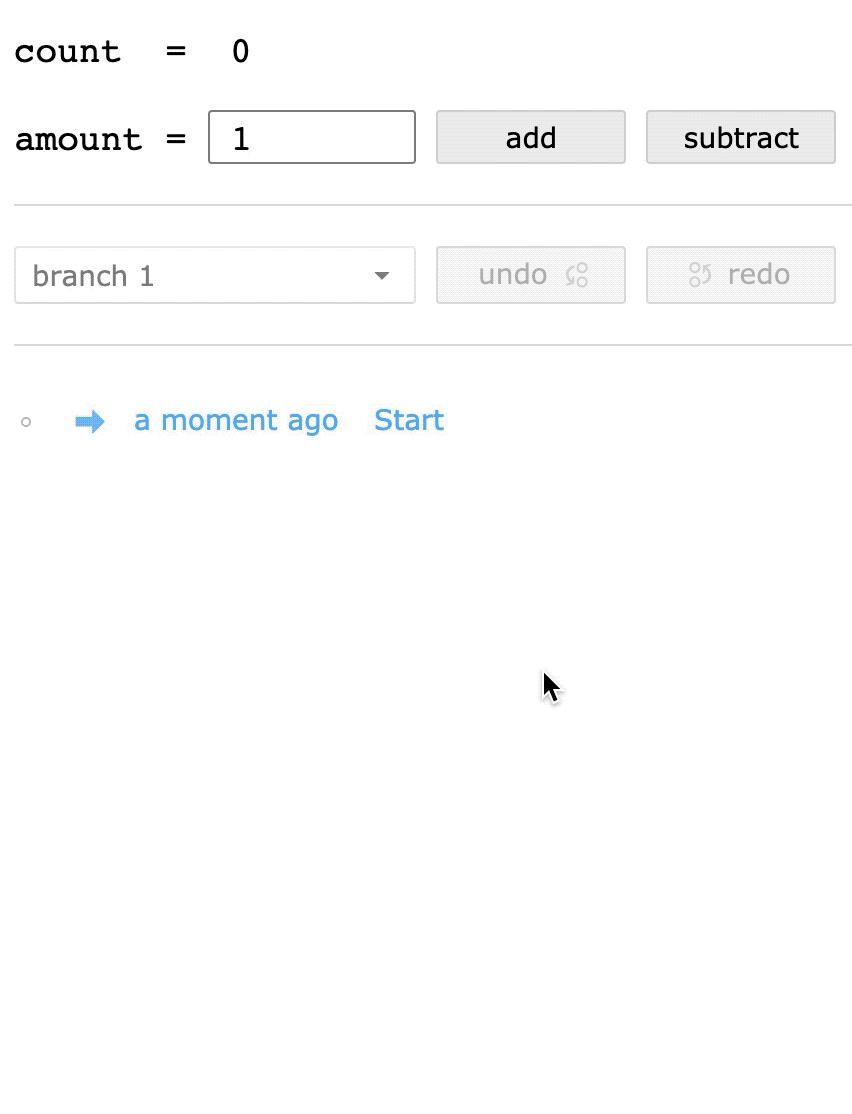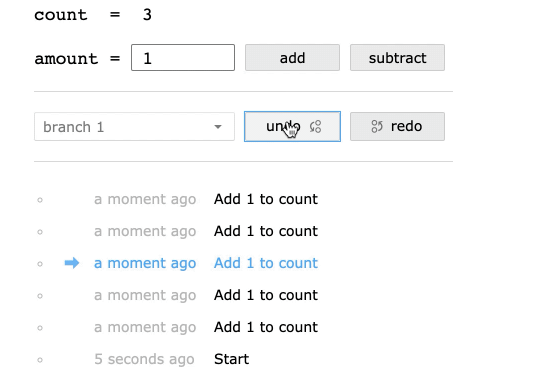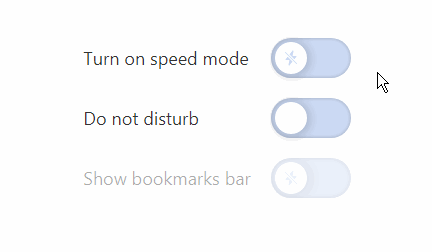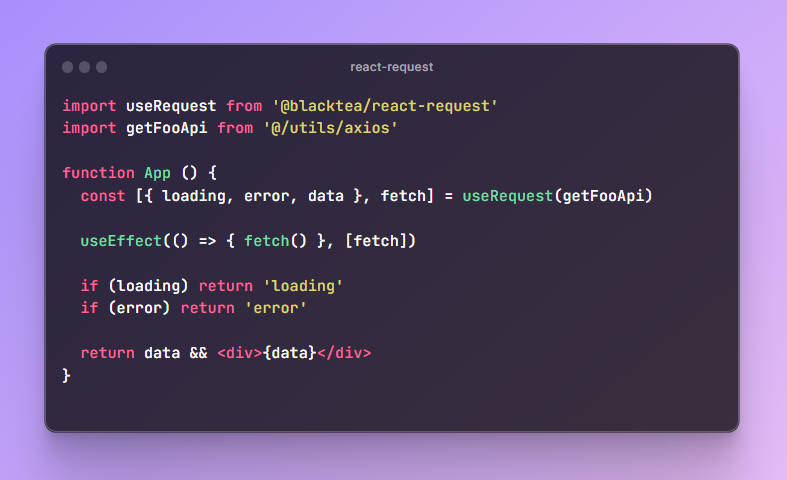use-flexible-undo
This library enables you to add a branching undo history to your React project. Because ... the very first thing every user will demand for any kind of app is a branching undo history!

All jokes aside, you might be interested in experimenting with undo-redo UI ? and/or implementation ?. This lib gives you two React hooks to do so. They work with a history of undoable actions (as opposed to a history of snapshots of app state). Both hooks offer identical functionality and an almost identical API, but they differ in how they integrate with your app state:
- useUndoableEffects allows you to add undo/redo functionality independently of how you manage your app state. Updates to app state are modelled as a side-effect of updates to undo history state. You can use this hook together with (multiple calls to) useState, useReducer or a combination thereof. Quite nice for prototyping.
- useUndoableReducer integrates your application state and the undo history state. This hook takes an undoable reducer which can be created with the included utility makeUndoableReducer.
The library does not contain UI-components.
Installation and usage
npm i use-flexible-undo
import { useUndoableEffects } from 'use-flexible-undo';
import { makeUndoableReducer, useUndoableReducer } from 'use-flexible-undo';
This lib is written in TypeScript so types for TS are included.
Examples
Check out the StoryBook for interactive examples with documentation and source code. Check out the examples below for a quick overview.
useUndoableEffects
The useUndoableEffects hook takes a handlers object with pairs of do/redo ("drdo") and undo handlers by action type, and returns an undoables object with undoable functions by action type.
If you use TypeScript then you can type the hook with a record of payload by action type ("PBT"). Alternatively you could type the payloads within the handlers and let PBT be inferred.
You are free to model the payloads however you like. Depending on your needs you can use them to store the state delta (see "add" and "subtract") or for example the old and the new state (see "updateAmount").
import React, { FC, useState } from 'react';
import { useUndoableEffects } from 'use-flexible-undo';
type nullber = number | null;
// action Payload By action Type
interface PBT {
add: number;
subtract: number;
updateAmount: {
from: nullber;
to: nullber;
};
}
export const MyFunctionComponent: FC = () => {
const [count, setCount] = useState(0);
const [amount, setAmount] = useState<nullber>(1);
const {
undoables,
canUndo,
undo,
canRedo,
redo,
history,
timeTravel,
switchToBranch,
} = useUndoableEffects<PBT>({
handlers: {
add: {
drdo: amount => setCount(prev => prev + amount),
undo: amount => setCount(prev => prev - amount),
},
subtract: {
drdo: amount => setCount(prev => prev - amount),
undo: amount => setCount(prev => prev + amount),
},
updateAmount: {
drdo: ({ to }) => setAmount(to),
undo: ({ from }) => setAmount(from),
},
},
});
const { add, subtract, updateAmount } = undoables;
return <> your UI here </>;
};
The library provides you with various utilities for generating your do/redo & undo handlers from your state setter functions. Using these utils has the added benefit that the payload types can be inferred. If you want you can of course still type the hook with a record of payload by action type, for some extra control.
Apart from these utilities, the following example illustrates the usage of most of the return values of the hook: The canUndo and canRedo booleans, the history state, and the undo, redo, timeTravel and switchToBranch functions. The example includes some basic inline UI, but in your project you probably want to split this up in multiple (styled) components ;)
import React, { FC, useState } from 'react';
import {
useUndoableEffects,
makeUndoableFTHandler,
makeUndoableHandler,
invertHandlers,
} from 'use-flexible-undo';
// following imports are not part of the library
import { addUpdater, subtractUpdater } from '../examples-util';
import {
rootStyle,
topUIStyle,
countStyle,
actionsStyle,
getStackItemStyle,
} from '../styles';
import { NumberInput } from '../components/number-input';
import { getLastItem } from '../components/util';
export const MyFunctionComponent: FC = () => {
const [count, setCount] = useState(0);
const [amount, setAmount] = useState<number | null>(1);
const undoableAddHandler = makeUndoableHandler(setCount)(
addUpdater, // amount => prev => prev + amount
subtractUpdater // amount => prev => prev - amount
);
const {
undoables,
canUndo,
undo,
canRedo,
redo,
history,
timeTravel,
switchToBranch,
} = useUndoableEffects({
// types are inferred from setCount / setAmount
handlers: {
add: undoableAddHandler,
subtract: invertHandlers(undoableAddHandler),
updateAmount: makeUndoableFTHandler(setAmount),
},
options: {
clearFutureOnDo: false,
// This is the default.
// Not clearing the future means making a new branch.
},
});
const { add, subtract, updateAmount } = undoables;
const { branches, currentBranchId, currentPosition } = history;
const { stack } = branches[currentBranchId];
// show the last-modified branch on top
const branchList = Object.values(branches).sort(
(a, b) =>
getLastItem(b.stack).created.getTime() -
getLastItem(a.stack).created.getTime()
);
return (
<div className={rootStyle}>
<div className={topUIStyle}>
<div className={countStyle}>count = {count}</div>
<div className={actionsStyle}>
<label>
amount =
<NumberInput
// simple util component that converts string
// to number/null and vice versa
value={amount}
onChange={value =>
updateAmount({
from: amount,
to: value,
})
}
/>
</label>
<button disabled={!amount} onClick={() => amount && add(amount)}>
add
</button>
<button disabled={!amount} onClick={() => amount && subtract(amount)}>
subtract
</button>
</div>
<div className={actionsStyle}>
<select
value={currentBranchId}
onChange={e => switchToBranch(e.target.value, 'HEAD_OF_BRANCH')}
>
{branchList.map(b => (
<option key={b.id} value={b.id}>
Branch {b.number}
</option>
))}
</select>
<button disabled={!canUndo} onClick={undo}>
undo
</button>
<button disabled={!canRedo} onClick={redo}>
redo
</button>
</div>
</div>
// we reverse the list so that we have the newest action on top
{stack
.slice() // copy, because reverse is a mutable operation
.reverse() // alternatively, you could try to reverse with css :)
.map(({ id, type, payload }, index) => (
<div
key={id}
// We need to recalculate the index due to the reversal.
// Or you can use 'timeTravelById' if you do not care about
// the lookup cost.
onClick={() => timeTravel(stack.length - 1 - index)}
className={getStackItemStyle({
active: id === currentPosition.actionId,
})}
>
{JSON.stringify({ type, payload })}
</div>
))}
</div>
);
};
When using useUndoableEffects you have to make sure that you get your state dependencies (in this case "amount") in your do/redo & undo handlers from either the action payload or the previous state, and not directly from the component state. Otherwise you may break time-travel. See this example to see this in action.
useUndoableReducer
If you want to keep your undo-history state and you application state integrated, and/or if you want to extract your state update logic from your component(s) for performance or testability, then you can create a reducer (from scratch or with the included utils). You can pass this reducer together with an object map of undo action creators by action type to makeUndoableReducer. The resulting undoable reducer can be used directly with React's useReducer, or you can provide it to useUndoableReducer. This is a simple wrapper for useReducer, and it gives you a similar API as useUndoableEffects.
The following example also shows that you are free to get your state dependencies from the previous state instead of from the action payload. This however does have a possible downside: You will not have direct access to the previous state for each action in the undo history UI, so the user will only see the action types.
import React, { FC } from 'react';
import {
makeUpdater,
makeFTHandler,
invertFTHandler,
makeReducer,
makeUndoableReducer,
useUndoableReducer,
} from 'use-flexible-undo';
import { addUpdater, subtractUpdater, merge } from '../examples-util';
type nullber = number | null;
interface State {
count: number;
amount: nullber;
}
interface PayloadByType {
add: void; // a void payload also means that the user will not see in
subtract: void; // the undo history UI how much was added/subtracted :(
updateAmount: {
from: nullber;
to: nullber;
};
}
// get 'amount' from the previous state instead of from the payload
const selectDependency = (payload: void) => (state: State) => state.amount || 0;
const countUpdater = makeUpdater(
(state: State) => state.count,
count => merge({ count })
)(selectDependency);
const { reducer, actionCreators } = makeReducer<State, PayloadByType>({
add: countUpdater(addUpdater),
subtract: countUpdater(subtractUpdater),
updateAmount: makeFTHandler(amount => merge({ amount })),
});
// create a higher-order reducer with separate action creators for 'undo'
const undoableReducer = makeUndoableReducer(reducer, {
add: actionCreators.subtract,
subtract: actionCreators.add,
updateAmount: invertFTHandler(actionCreators.updateAmount),
});
export const MyFunctionComponent: FC = () => {
const { state, undoables, ...etc } = useUndoableReducer({
undoableReducer,
actionCreators,
initialState: {
count: 0,
amount: 1,
},
});
const { count, amount } = state;
const { add, subtract, updateAmount } = undoables;
return <> your UI here </>;
};
A bit more experimental: You can also make a reducer that handles the undo cases internally, based on the { meta: { isUndo: boolean }} part of the actions. This means that you do not need to provide the undo action creators to makeUndoableReducer, but it has the possible downside that it is harder to see the difference between undo and redo in something like Redux-devtools.
const selectDependency = (payload: void) => (state: State) => state.amount || 0;
const undoableAddUpdater = makeUndoableUpdater(
(state: State) => state.count,
count => merge({ count })
)(selectDependency)(addUpdater, subtractUpdater);
// 'undo' case is handled by the reducer internally
const { unducer, actionCreators } = makeUnducer<State, PayloadByType>({
add: undoableAddUpdater,
subtract: invertHandlers(undoableAddUpdater),
updateAmount: makeUndoableFTHandler(amount => merge({ amount })),
});
// no need to pass action-creators for 'undo'
const undoableReducer = makeUndoableReducer(unducer);
Roadmap
- not-so-distant future: add tests
- distant future: non-linear undo ?





